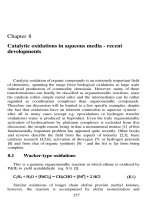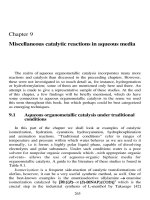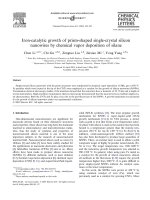Catalytic Reforming
Bạn đang xem bản rút gọn của tài liệu. Xem và tải ngay bản đầy đủ của tài liệu tại đây (1.13 MB, 68 trang )
Catalytic Reforming
Catalytic Reforming
Under Supervision of
Under Supervision of
Dr. El-Shazly Salem
Dr. El-Shazly Salem
Eng. Hossam Hosny Mohamed El-Ghareeb
Eng. Hossam Hosny Mohamed El-Ghareeb
Eng. Mohamed Mohamed Refaat Ibrahiem
Eng. Mohamed Mohamed Refaat Ibrahiem
Eng. Mahmoud Ibrahiem Mohamed Mohamed
Eng. Mahmoud Ibrahiem Mohamed Mohamed
Eng. Mustafa Mahmoud Abd-ALLAH
Eng. Mustafa Mahmoud Abd-ALLAH
Eng. Mohamed Saied Abu Basha
Eng. Mohamed Saied Abu Basha
Antiknock Quality Problem
Antiknock Quality Problem
Low Octane Rating of Gasoline vs. Demand
Low Octane Rating of Gasoline vs. Demand
Noise and Loss in Energy
Noise and Loss in Energy
Solutions to the Problem
Solutions to the Problem
Addition of High O.N. Compounds
Addition of High O.N. Compounds
Tetra Ethyl Lead (TEL)
Tetra Ethyl Lead (TEL)
Oxygenates (MTBE & TAME)
Oxygenates (MTBE & TAME)
Alteration of the Chemical Composition
Alteration of the Chemical Composition
Thermal Reforming
Thermal Reforming
Catalytic Reforming
Catalytic Reforming
Catalytic vs. Thermal Reforming
Catalytic vs. Thermal Reforming
Catalytic
Catalytic
Higher Octane
Higher Octane
Number: 90 to 100
Number: 90 to 100
Lower Temp. ≈ 500°C
Lower Temp. ≈ 500°C
Higher H
Higher H
2
2
Production
Production
Trace Olefins Contents
Trace Olefins Contents
Pt/Alumina Catalyst
Pt/Alumina Catalyst
Thermal
Thermal
Lower Octane
Lower Octane
Number: 65 to 80
Number: 65 to 80
Higher Temp. ≈ 600°C
Higher Temp. ≈ 600°C
Lower H
Lower H
2
2
Production
Production
High Olefins Contents
High Olefins Contents
Without Catalyst
Without Catalyst
Feed Treatment By Hydrogen
Feed Treatment By Hydrogen
Removal of:
Removal of:
Nitrogen as Ammonia
Nitrogen as Ammonia
Sulfur as H
Sulfur as H
2
2
S
S
Oxygen as Water
Oxygen as Water
Saturation of Olefins Present in Special
Saturation of Olefins Present in Special
Feeds
Feeds
The Catalytic Reforming Process
The Catalytic Reforming Process
Aims of Process:
Aims of Process:
Max. ON
Max. ON
…………
…………
By Conversion
By Conversion
Min. Capacity to form Gums
Min. Capacity to form Gums
……
……
By Saturation
By Saturation
Production of Hydrogen for other Processes
Production of Hydrogen for other Processes
Production of BTX for the Petrochemical Industry
Production of BTX for the Petrochemical Industry
Feed To Catalytic Reforming
Feed To Catalytic Reforming
Sources of Feed:
Sources of Feed:
HSR Naphtha (90°C to 160°C)
HSR Naphtha (90°C to 160°C)
Not LSR
Not LSR
……………
……………
Why?
Why?
Not Heavier
Not Heavier
……………
……………
Why?
Why?
Visbreaking & Coking Gasolines
Visbreaking & Coking Gasolines
Hydrocracking
Hydrocracking
Two Typical Feeds Composition
Two Typical Feeds Composition
Paraffinic
(Arabian Light)
Naphthenic
(Nigeria)
RON 50 66
Av. Mw. 114 119
S
(weight ppm)
500 350
Paraffins 66.8 29.3
Naphthenes 21.8 61.85
Aromatics 11.4 8.85
Total Change to The Feed
Total Change to The Feed
Catalytic Reforming Product
Catalytic Reforming Product
Relation between ON and Reformate Yield
Relation between ON and Reformate Yield
Reformate Composition
Reformate Composition
Number
of carbon
atoms
nP iP P O N A Total
4
5
6
7
8
9
10
11
Total
0.57
1.51
1.69
2.5
1.16
0.26
0.07
0
7.76
2.37
1.97
8.42
4.91
1.04
0.28
0.02
21.01
0.57
3.88
5.66
10.92
6.07
1.3
0.35
0.02
28.77
0.1
0.16
0.35
0.44
0.08
0
0
1.13
0
0.19
0.4
0.34
0
0
0
0.93
2.34
14.16
26.28
21.08
4.76
0.55
69.17
3.98
8.35
25.83
33.13
22.46
5.11
0.57
100
nP: normal paraffins. iP: branched paraffins. P: total paraffins.
O: olefins. N: naphthenes. A: aromatics
Reformate Composition
Reformate Composition
Reformate Composition
Reformate Composition
Catalytic Reforming Technology
Catalytic Reforming Technology
Fixed-Bed Technology
Fixed-Bed Technology
Non-Regenerative
Non-Regenerative
……
……
Replacement (months)
Replacement (months)
Semi-Regenerative
Semi-Regenerative
……
……
Shutdown (years)
Shutdown (years)
Regenerative (Cyclic)
Regenerative (Cyclic)
……
……
Switching (days)
Switching (days)
Moving-Bed Technology
Moving-Bed Technology
Fluid-Bed Technology
Fluid-Bed Technology
Fixed-Bed Technology
Fixed-Bed Technology
Type of Reactors
Type of Reactors
Fixed-Bed Technology
Fixed-Bed Technology
Reactor Configuration
Reactor Configuration
Fixed-Bed Technology
Fixed-Bed Technology
Temperature Variation in Reactors
Temperature Variation in Reactors
Fixed-Bed Technology
Fixed-Bed Technology
Variation in Effluent Composition
Variation in Effluent Composition
Fixed-Bed Technology
Fixed-Bed Technology
Non-Regenerative Technique
Non-Regenerative Technique
The First Technique to be used (used by UOP)
The First Technique to be used (used by UOP)
High Pressures (above 35 bars)
High Pressures (above 35 bars)
Catalyst Life of 10 months
Catalyst Life of 10 months
Catalyst is replaced & Regenerated off-site
Catalyst is replaced & Regenerated off-site
Low Severity & High Pressures
Low Severity & High Pressures
……
……
led to switching
led to switching
to the (semi-regenerative) Technique
to the (semi-regenerative) Technique
Fixed-Bed Technology
Fixed-Bed Technology
Semi-Regenerative (SR) Technique
Semi-Regenerative (SR) Technique
Catalyst life of 7-10 years
Catalyst life of 7-10 years
Regeneration causes the Total Shutdown of System
Regeneration causes the Total Shutdown of System
Regeneration is carried out inside the system
Regeneration is carried out inside the system
Fixed-Bed Technology
Fixed-Bed Technology
Semi-Regenerative (SR) Technique
Semi-Regenerative (SR) Technique
Fixed-Bed Technology
Fixed-Bed Technology
Regenerative (Cyclic) Technique
Regenerative (Cyclic) Technique
Shutting Down is avoided by an Extra Reactor
Shutting Down is avoided by an Extra Reactor
Complex Valve System, Reactor Central Position
Complex Valve System, Reactor Central Position
Modes of Run: (Cyclic) or (Swing)
Modes of Run: (Cyclic) or (Swing)
Catalyst Life of about 5-15 days
Catalyst Life of about 5-15 days
Higher ON for the same Yield, and vice versa
Higher ON for the same Yield, and vice versa
5 Units higher ON than Semi-Regenerative
5 Units higher ON than Semi-Regenerative
“
“
Ultraforming
Ultraforming
”
”
and EXXON
and EXXON
“
“
Powerforming
Powerforming
”
”
Fixed-Bed Technology
Fixed-Bed Technology
EXXON Powerformer
EXXON Powerformer
Moving-Bed Technology
Moving-Bed Technology
Moving-Bed Advantages:
Moving-Bed Advantages:
Higher ON even from difficult feeds
Higher ON even from difficult feeds
All-year run, producing the H
All-year run, producing the H
2
2
that refineries need
that refineries need
Catalysts are less stable over time but more selective
Catalysts are less stable over time but more selective
making it possible to improve yields
making it possible to improve yields
Lower recycle rates, which improve yields and reduce
Lower recycle rates, which improve yields and reduce
operating costs
operating costs
Lower operating pressures which favors reformate
Lower operating pressures which favors reformate
yields and hydrogen production
yields and hydrogen production
Moving-Bed Technology
Moving-Bed Technology
Reactor Configuration:
Reactor Configuration:
“
“
One on the top of the other
One on the top of the other
”
”
, which is carried out by
, which is carried out by
UOP
UOP
“
“
Side by Side
Side by Side
”
”
, which is carried out by IFP
, which is carried out by IFP
UOP regeneration is
UOP regeneration is
“
“
Continuous
Continuous
”
”
IFP can be either
IFP can be either
“
“
Continuous
Continuous
”
”
or
or
“
“
Batch
Batch
”
”
Moving-Bed Technology
Moving-Bed Technology
UOP:
UOP:
“
“
CCR Platformer
CCR Platformer
®”
®”









